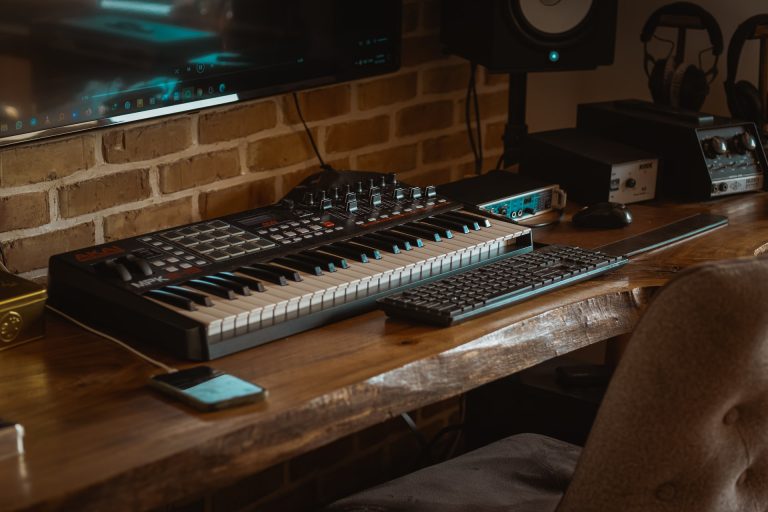Soundproofing is simply the method of limiting the passage of sound by absorbing it. All recording or streaming studios soundproof their rooms because nothing’s worse than having background noise during sessions. But it doesn’t mean normal people like us can’t enjoy the benefits of a soundproofed room.
For a homeowner, it can address external noises, like traffic and noisy neighbors, or internal noises, like loud instruments and noisy kids. Whether you live in an apartment or suburban home, any unwanted noise can be an issue that affects all home types. Finding the best way to soundproof a room can be an effective way to get some peace.
As mentioned earlier, to reduce noise, you need to absorb sound. Everything absorbs sounds to a degree. Determining the correct materials and their forms will be key to shutting out noise.
Can I Completely Soundproof a Room?
For a normal homeroom, 100% noise cancellation is impossible. However, it’s possible to soundproof a room just enough for your needs. To get most out of your soundproofing, you’ll need to address the source of the sound—where it comes from and where it bounces.
Depending on those two factors,—and your budget—you may use a sound booth, acoustic panels, acoustic foam, curtains, or window inserts to block incoming noise.
Soundproofing a Room Without Spending Money
If you don’t want to spend any money, you’ll have to use what you already own. Your room might not have studio quality noise reduction, but at least you can keep the sounds of dog barking at bay.
Use floor mats and carpets. People often forget to soundproof hard floors. Sound bounces everywhere and hard surfaces reflect sound the most. The simplest solution for hard floors is to lay down floor mats or carpets to help absorb sound.
Better position your upholstered furniture and decor to absorb more sound. One of the easiest ways to reduce noise is to give more areas for sound to be absorbed naturally. As mentioned earlier, determine the source of the sound and where it can bounce. Having that knowledge will give you a better idea of how to position your furniture and home decor. Simply having a better home layout keeps sound from bouncing as much.
Cheapest Way to Soundproof a Room
Soundproofing a room doesn’t need to be expensive. There are plenty of ways to soundproof a room that doesn’t involve too much work or spending a lot of money.
If you’re interested in soundproofing a room, chances are that you’ll want it to be simple and easy. Techniques below are all additive and don’t require any construction, which is great for people living in apartments or rentals that can’t change their place too much.
Make use of window inserts. Not the prettiest option, but window inserts are great if you’re looking to block outside noise but not the view from your apartment. They are clear-glass or acrylic panels that you install over your windows. Window inserts create an airtight seal trapping sound that effectively reduces noise. Most modern window inserts come with a quick pop out design, making it convenient to open the window for fresh air.
Add weatherstrips to your doors. Doors are vulnerable to noise coming in and out because they have gaps around them. To fix this, weatherstrips seal the gap in your door jambs and underneath the door, which reduces the noise well.
Fill in your bookshelf. Odd as it may seem, bookshelves add soundproofing for a room. The shelves themselves should be filled with books in order to build mass. Since you’re basically adding another layer to your wall, you can absorb more sound—the more surface area it covers, the better. If you’re into books, you have another reason to set up a bookshelf.
Affordable High Quality Soundproofing
Willing to spend a little more money, but don’t know what to buy? We got two items that are known to drastically reduce sound for your room.
Make use of acoustic foam panels. If you need a quieter room, go buy some acoustic panels. Made from superior noise-dampening materials, acoustic panels come with a pattern structure to absorb sound. Depending on the size and quality, acoustic panels can be quite expensive, but there are also cheap options. However, investing in a higher price is worth it, especially if you have a home studio and really need a quiet room.
The great thing about acoustic panels is that while they are excellent at absorbing sound, you can treat them as art or accents to your room. They come in different colors and patterns to match your decor so you can be creative with them. They are also easy to install since they’re lightweight—use hanging strips to stick them to your wall or ceiling. Alternatively, if you’re using a lot of panels, you can stick them to a mounting board before placing it on your wall or ceiling.
Just like any other soundproofing method, place the panels on the opposite wall of the source of the sound. Sound bounces similar to a rubber ball where it bounces back at an angle equal to where it came.
Invest in vibration insulation pads and foam. Floor mats and other thick foams are great for absorbing vibration. Since sound waves are vibrations, you can reduce sound by reducing vibrations. Thus, any device or machinery that produces strong vibrations like speakers, appliances, treadmills, can create a lot of noise. Mount all of it on a dense foam rubber like a gym floor mat or vibration insulation pads to dampen the vibrations.
Soundproofing a Room With a Bigger Budget
For the more dedicated homeowners that plan on having a theater room, recording room, or streaming room, you have a lot of options. You can spend on higher quality additive changes stated above or convert your entire room from the ground up.
Construct a second layer of drywall lined with sheet blocks. Either doing it yourself or hiring a professional, you’ll have to lose a few inches of space around your room. The space created will act as a sound isolation barrier on your wall.
In the space between the two walls, sheets of mass-loaded vinyl or sheet block—high quality noise absorbing materials—are added and leave an air gap. The sheet block and the second wall keep sound waves from entering or exiting through your walls. By adding another layer, the volume of sound your wall can isolate is enormous, resulting in a silent room.
Setup a customized sound booth. If you’ve got a higher budget and want to have complete control of your space, consider using a sound booth. A custom sound booth offers distraction-free audio since all sound is either blocked out by insulation or canceled out with advanced technology. You can expect to get the cleanest sound while having complete control of all variables.
A sound booth comes with all the devices and equipment you’ll need, while another room contains all the equipment to process your sound and mix it properly.
Final Thoughts
Sound or Noise is everywhere and affects many aspects of our daily lives and the lives of others. A responsible person will hate to bother other people in the house or outside with the noise they’re making.
However, a more important reason we want to soundproof our rooms is to stop noise from getting into our rooms. Whether we have a recording room setting or a home theater room, it’s important to limit noise to a minimum.
Before getting started, know the basics of determining the source of the sound and where it can bounce. For example, if you live close to the street, hang thick curtains over the windows to block traffic noise. If you’re in an apartment and the noise is coming from downstairs neighbors, use wide area rugs to insulate the floor. Also strategically rearrange the furniture to better absorb sound.
These are simple adjustments you can do in a day that can already give you a better sound experience. However, the best way to stop noise is without a doubt putting in a little money using acoustic foams or panels.
Obviously, taking the steps to reduce the nuisance caused by excessive sound is rewarding and has other significant benefits—increased oral participation of elderly people, increased speech cognitive functions in children, and cultivation of personal peace. That’s why soundproofing has become more affordable and accessible to people because of its demand. We deserve to have peace and quiet in our own homes.


